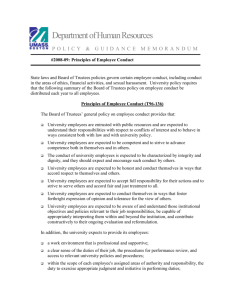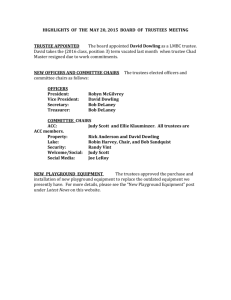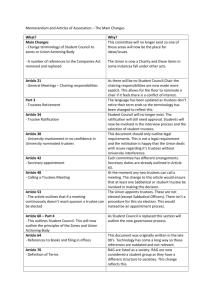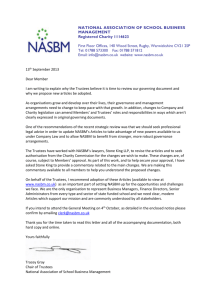Trustee Orientation: A Checklist for CEOs and Board Chairs
advertisement
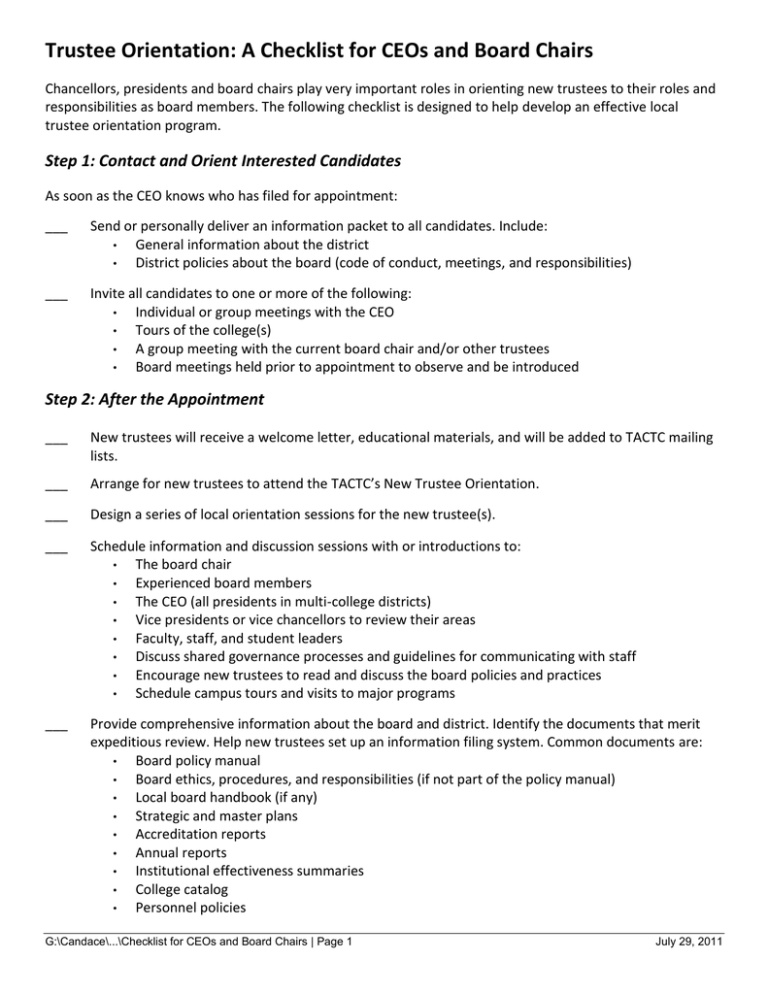
Trustee Orientation: A Checklist for CEOs and Board Chairs Chancellors, presidents and board chairs play very important roles in orienting new trustees to their roles and responsibilities as board members. The following checklist is designed to help develop an effective local trustee orientation program. Step 1: Contact and Orient Interested Candidates As soon as the CEO knows who has filed for appointment: ___ Send or personally deliver an information packet to all candidates. Include: • General information about the district • District policies about the board (code of conduct, meetings, and responsibilities) ___ Invite all candidates to one or more of the following: • Individual or group meetings with the CEO • Tours of the college(s) • A group meeting with the current board chair and/or other trustees • Board meetings held prior to appointment to observe and be introduced Step 2: After the Appointment ___ New trustees will receive a welcome letter, educational materials, and will be added to TACTC mailing lists. ___ Arrange for new trustees to attend the TACTC’s New Trustee Orientation. ___ Design a series of local orientation sessions for the new trustee(s). ___ Schedule information and discussion sessions with or introductions to: • The board chair • Experienced board members • The CEO (all presidents in multi-college districts) • Vice presidents or vice chancellors to review their areas • Faculty, staff, and student leaders • Discuss shared governance processes and guidelines for communicating with staff • Encourage new trustees to read and discuss the board policies and practices • Schedule campus tours and visits to major programs ___ Provide comprehensive information about the board and district. Identify the documents that merit expeditious review. Help new trustees set up an information filing system. Common documents are: • Board policy manual • Board ethics, procedures, and responsibilities (if not part of the policy manual) • Local board handbook (if any) • Strategic and master plans • Accreditation reports • Annual reports • Institutional effectiveness summaries • College catalog • Personnel policies G:\Candace\...\Checklist for CEOs and Board Chairs | Page 1 July 29, 2011 ___ Consider assigning or offering a “mentor” from the board • Use experienced trustees who will be able to gain the confidence of the new trustee. • Offer assistance and feedback on board culture and boardsmanship – not opinions on how to vote. ___ Help new trustees strengthen their links to the external community and public. • Arrange for invitations to new trustees to community events or meetings with key community people. Be sure they are introduced as new trustees. • Invite them to attend a Foundation board meeting. • Provide information about trends and educational needs in the community. • Provide information about the college to help new trustees be knowledgeable representatives. ___ Maintain ongoing communication links • Board chairs and “mentors” initiate contact. • Encourage new trustees to ask questions and seek information prior to board meetings. Offer to meet with them prior to board meetings for the first few months. • Discuss lines of communication and who to ask for what information. • Ask new trustees what their preferred mode of communication is. Use that style to the extent practical. • Set up an e-mail address and include them in routine communication. • Call new trustees before board meetings to see if they have any questions. ___ Encourage new trustees to seek educational opportunities. • Notify them of all upcoming state and national conferences (particularly those sponsored by TACTC and ACCT). • Establish an expectation for new trustees to attend conferences; explain how to obtain travel support. • Strengthen partnerships and teamwork by arranging for the CEO and/or other board members to accompany new trustees to conferences and introduce them to others. New trustees have varied learning needs and styles, backgrounds, motivations for being on the board, schedules and desires for learning opportunities. Therefore, the orientation process will be different for each new trustee. The time and effort involved in providing a substantive overview and discussion of the district and trustee roles and responsibilities will reap future benefits. The time and effort will help ensure new board members are well-informed and participate effectively in the unit that is the board. G:\Candace\...\Checklist for CEOs and Board Chairs | Page 2 July 29, 2011


